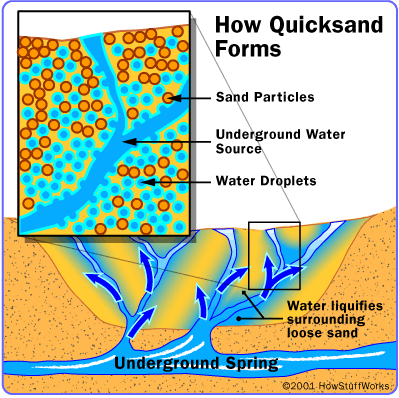
How Quicksand Works
With quicksand, the more you struggle in it the faster you will sink. If you just relax, your body will float in it because your body is less dense than the quicksand.
How many times have you watched a movie where the hero is sucked down into a pit of quicksand, only to be saved at the last minute by grabbing a nearby tree branch and pulling himself out?
If you believed what you saw in movies, you might think that quicksand is a living creature that can suck you down into a bottomless pit, never to be heard from again. But no — the actual properties of quicksand are not quite those portrayed in the movies.
Quicksand is not quite the fearsome force of nature that you sometimes see on the big screen. In fact, the treacherous grit is rarely deeper than a few feet.
It can occur almost anywhere if the right conditions are present. Quicksand is basically just ordinary sand that has been so saturated with water that the friction between sand particles is reduced. The resulting sand is a mushy mixture of sand and water that can no longer support any weight.
If you step into quicksand, it won’t suck you down. However, your movements will cause you to dig yourself deeper into it. In this article, you will learn just how quicksand forms, where it’s found and how you can escape its clutches if you find yourself hip-deep in it.
Next, we’ll find out how the ground shaking beneath your feet can lead to sand slipping beneath your weight.
What’s Quicksand?
Quicksand is an interesting natural phenomenon — it is actually solid ground that has been liquefied by a saturation of water. The “quick” refers to how easily the sand shifts when in this semiliquid state.
Quicksand is not a unique type of soil; it is usually just sand or another type of grainy soil. Quicksand is nothing more than a soupy mixture of sand and water. It can occur anywhere under the right conditions, according toDenise Dumouchelle, geologist with the United States Geological Survey (USGS).
Quicksand is created when water saturates an area of loose sand and the ordinary sand is agitated. When the water trapped in the batch of sand can’t escape, it creates liquefied soil that can no longer support weight. There are two ways in which sand can become agitated enough to create quicksand:
Flowing underground water – The force of the upward water flow opposes the force of gravity, causing the granules of sand to be more buoyant.
Earthquakes – The force of the shaking ground can increase the pressure of shallow groundwater, which liquefies sand and silt deposits. The liquefied surface loses strength, causing buildings or other objects on that surface to sink or fall over.
Vibration tends to enhance the quickness, so what is reasonably solid initially may become soft and then quick, according to Dr. Larry Barron of the New South Wales Geological Survey.
The vibration plus the water barrier reduces the friction between the sand particles and causes the sand to behave like a liquid. To understand quicksand, you have to understand the process of liquefaction. When soil liquefies, as with quicksand, it loses strength and behaves like a viscous liquid rather than a solid, according to the Utah Geological Survey. Liquefaction can cause buildings to sink significantly during earthquakes.
While quicksand can occur in almost any location where water is present, there are certain locations where it’s more prevalent. Places where quicksand is most likely to occur include:
Riverbanks
Beaches
Lake shorelines
Near underground springs
Marshes
The next time you’re at the beach, notice the difference in the sand as you stand on different parts of the beach that have varying levels of moisture. If you stand on the driest part of the beach, the sand holds you up just fine. The friction between the sand particles creates a stable surface to stand on.
If you move closer to the water, you’ll notice that the sand that is moderately wet is even more tightly packed than the dry sand. A moderate amount of water creates the capillary attraction that allows sand particles to clump together. This is what allows you to build sand castles.
But beach sand could easily become quicksand if enough water were thrust up through it. If an excessive amount of water flows through the sand, it forces the sand particles apart. This separation of particles causes the ground to loosen, and any mass on the sand will begin to sink through it. In the next section, you will find out how to save yourself if you happen to fall into a pit of quicksand.

